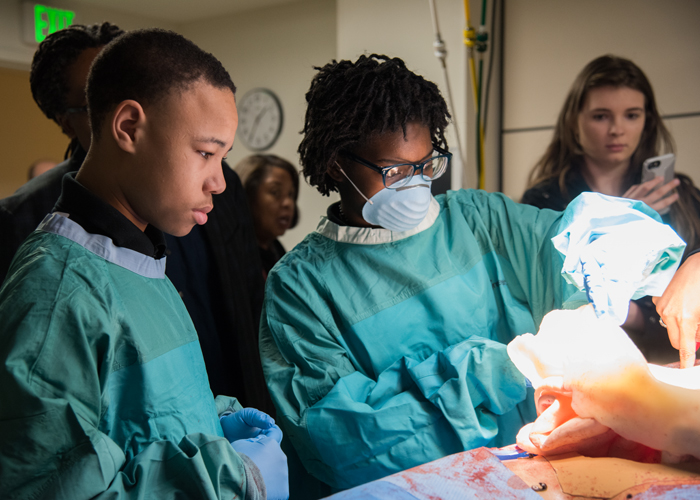Putting Baltimore Students on the Fast Track to Medicine
When Laura Buchanan, MD, was asked to set up a Stop the Bleed training session for students from P-TECH Healthcare at Dunbar, she decided to take the training a step further. The assistant professor at the University of Maryland School of Medicine and trauma surgeon at the R Adams Cowley Shock Trauma Center decided to invite the ninth-grade high school students to spend the entire day at the trauma center so they could experience what it’s like to work in the medical field.
(View a photo gallery.)

The P-TECH students learn how trauma surgeons prepare for emergency surgery with an exploratory laparotomy simulation on a medical mannequin.
“This was the perfect setting to bring all the health care specialties they’re studying together in one hands-on learning experience,” said Buchanan.
On March 18, the group of 35 ninth-graders was able to visit the center and work directly with health care professionals in different areas of medicine, including physical therapy, respiratory therapy, nursing, and trauma surgery. The unique experience gave them the opportunity to use the trauma simulators that health care professionals use to practice treating real patients.
(View a video below.)
“I think it’s impactful to give them this experience so they can see what medicine really is,” explained Pamela Smith-McNeal, RRT-EMCO specialist and special projects coordinator for Shock Trauma. “They see there are other aspects to medicine. It’s not just a doctor or a nurse, but it’s a full team of people that help a person from the time they enter through the trauma center to when they go home.”
The visiting students are part of the P-TECH program, which stands for Pathways in Technology Early College High School. The program puts them on an accelerated academic track, so they will be able to graduate from high school with a diploma and an associate degree. Many of the students are working toward a degree in the medical field, so they have already begun the coursework to become a health care professional.
“Because these students are in an accelerated program, we really wanted to make sure they got the chance to get some professional exposure,” explained Brian Sturdivant, MSW ’00, the University of Maryland, Baltimore’s director of community partnerships and strategic initiatives. Sturdivant was the point person who reached out to Buchanan about organizing a Shock Trauma visit for the P-TECH students. “This visit should be extremely helpful in exposing them to all kinds of careers within the health care profession and help them to get some really good advice on their school project.”
Right now, the students are working on a case study project in which they are given a fictional trauma patient, a 16-year-old girl, who has been in a car accident. Together, the students must come up with a treatment plan for her.
“By coming to the Shock Trauma Center, they’re able to get one-on-one information from experts and it’s really helping them, not just with their project, but with their education in general,” said Robert Nolan, a teacher and extended day coordinator for the P-TECH students. “It’s one thing to sit in a lecture and listen to someone talking. It’s quite another thing to learn hands-on.”
The students certainly got a full day of hands-on learning. They started the day by earning their certification in Stop the Bleed training, which teaches how to control bleeding in emergency situations.
After receiving their certification, the students got to participate in five critical trauma simulations led by students, faculty, and staff at Shock Trauma. The simulations gave the ninth-graders a crash course in each area of medicine, something that most students have to wait until college to experience.
Smith-McNeal led them in the respiratory therapy simulation. She walked them through how to care for a patient who needs a ventilator to breathe. She also showed them how to deliver oxygen and how to intubate a patient using a medical training mannequin.
“I think we did a good job giving them insight on everything trauma,” said Smith-McNeal. “At the beginning of the day, I only had two students interested in becoming respiratory therapists, and at the end of the class I had five!”
After that, a registered nurse showed the students how to wrap a patient with an open wound and how to place an IV tube. A physical therapist showed the students how to apply mobility exercises to a patient who is in rehab for an injury. A trauma surgeon showed the students how to use laparoscopic tools for less-invasive surgeries. And a trauma surgery student helped the students scrub in for an exploratory laparotomy simulation in which they got to put on a trauma gown and perform surgery on a realistic trauma mannequin.
“I think this experience is really going to help get them more excited about getting their associate degrees,” said Buchanan. “This way, they get to see what they’re signing up for and what all the extra work they’ll be doing in high school is pushing them toward.”
After the visit, many of the P-TECH students expressed interest in following a trauma-centered career path. This is something that Smith-McNeal was thrilled to hear.
“It’s really rewarding to see these kids’ eyes open up to what’s out there in the medical field,” she concluded. “I hope they come back and visit again and again.”



